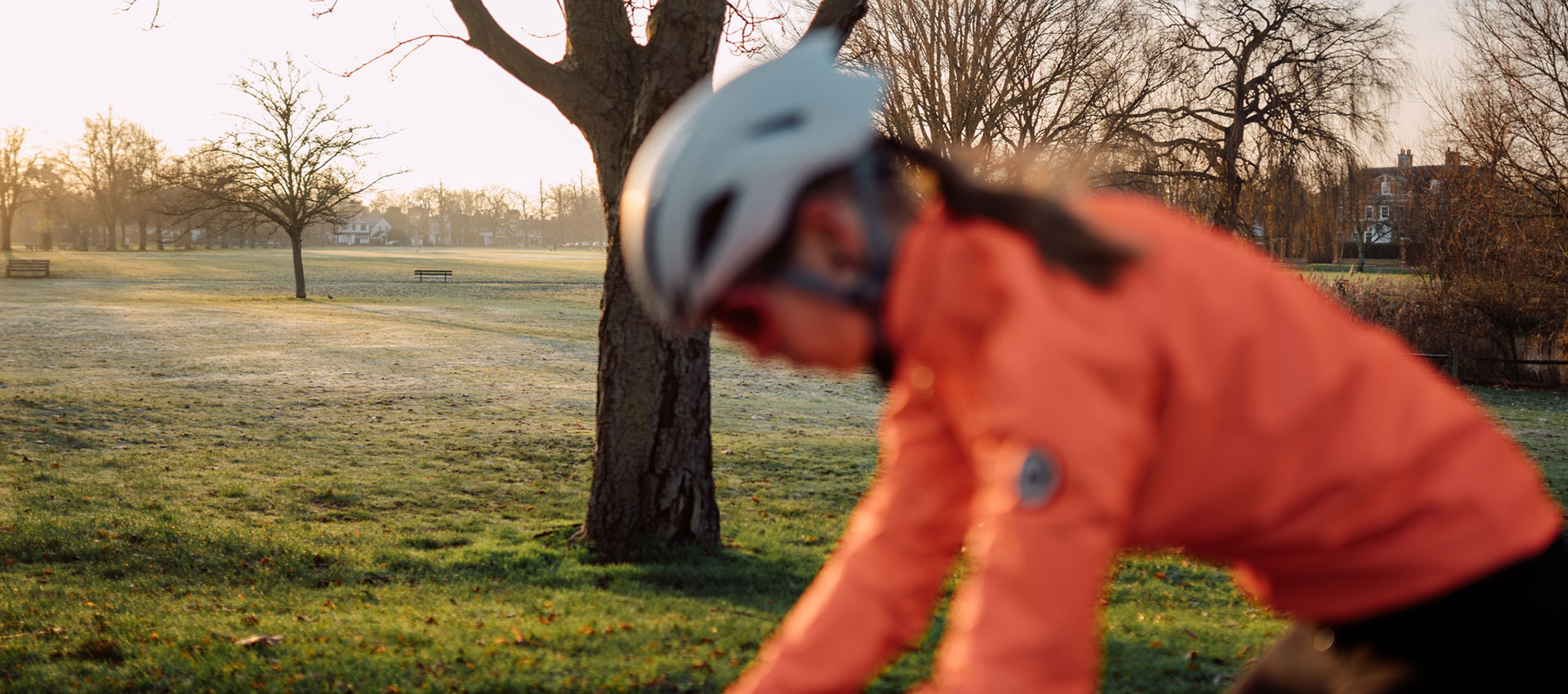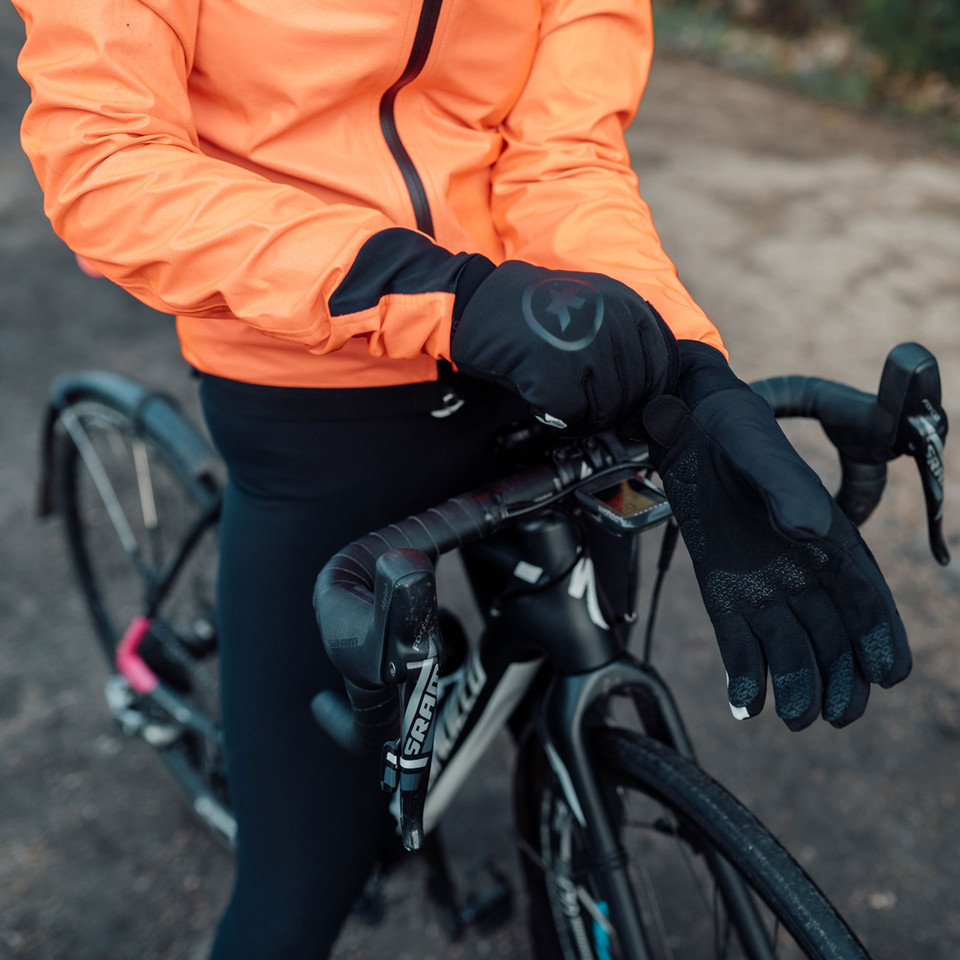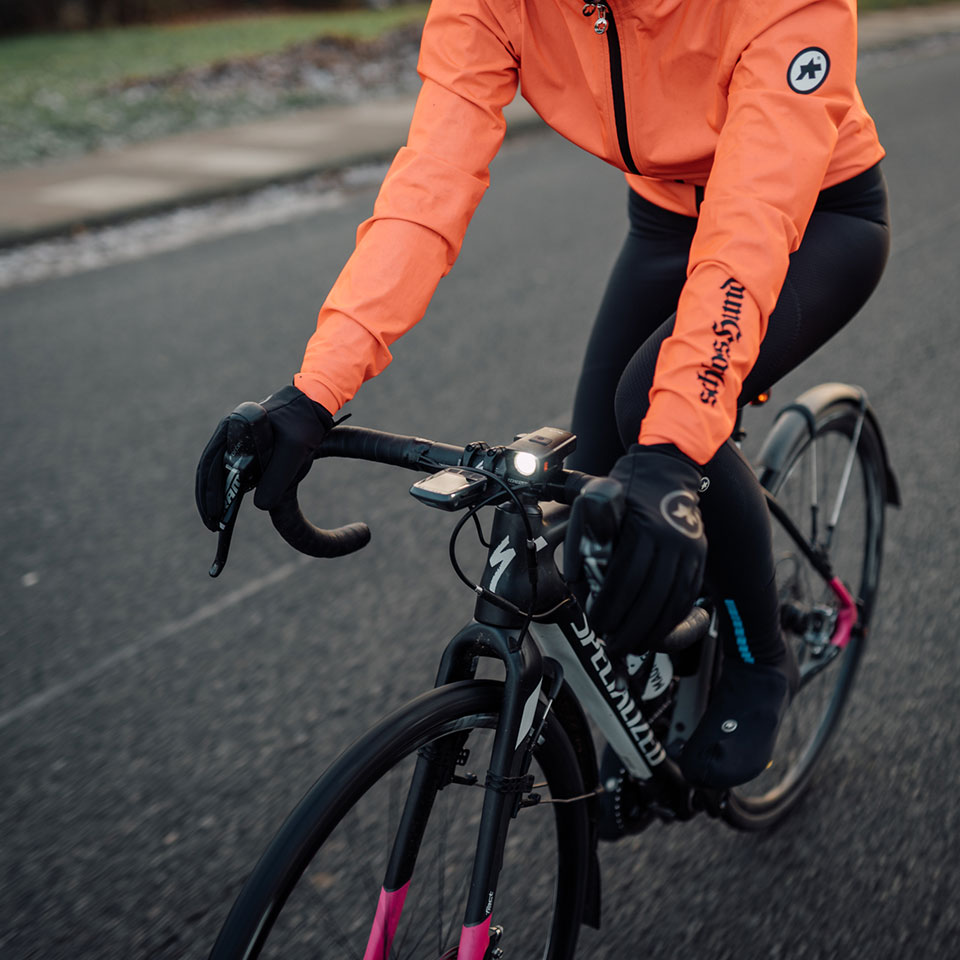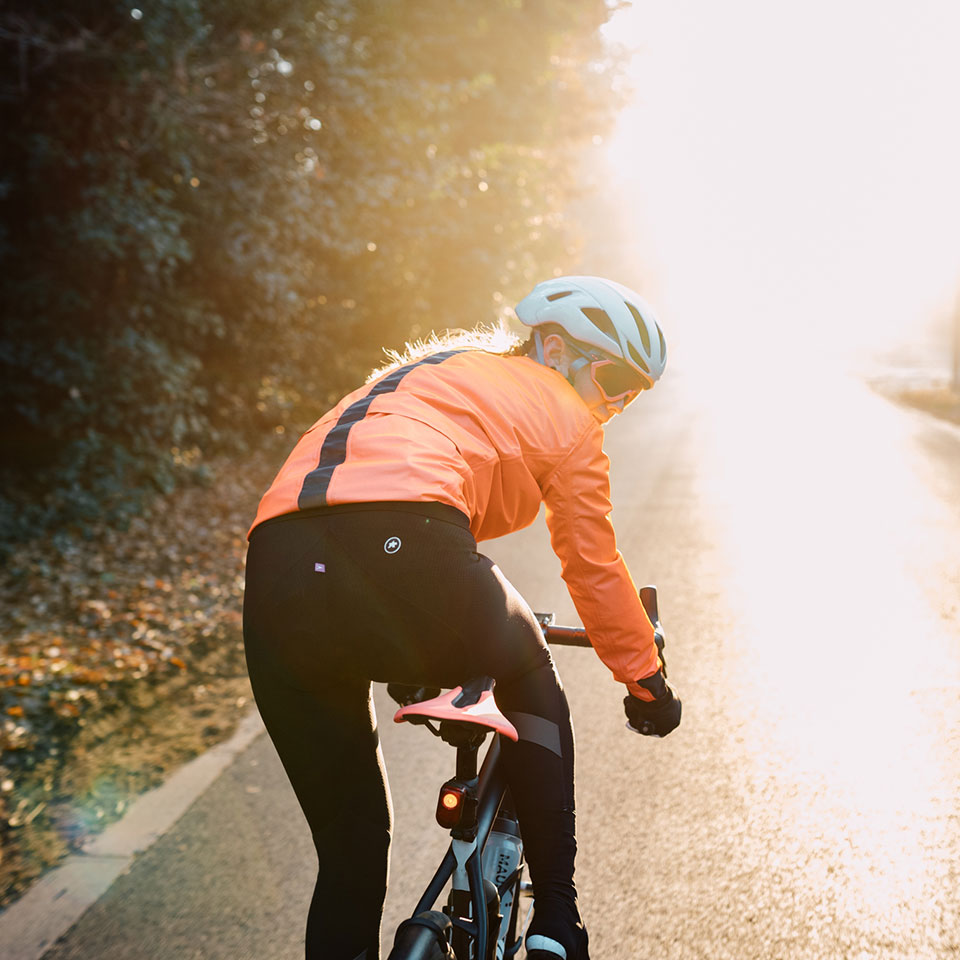
Winter Cycling:
Cold Weather Riding Tips & Bike Prep
Harsh conditions when cycling through winter is an inevitability of living in the northern hemisphere. It goes with the territory. Clocks change, leaves fall and suddenly, seemingly without warning, we're shivering in the wrong kit or getting caught out with insufficient lights during the off season.
As the seasons transition and temperatures swing teasingly back-and-forth from sharp and frosty to humid and wet, so we should also be making adjustments to how we ride and how we prepare our kit to deal with the short days and unpredictable conditions. Set yourself up properly for riding in winter and you will stay safe, stay fit and lay down a great base for the season ahead.

Keep the Extremities Warm
Before even setting off, ensuring your extremities are protected, ready for whatever conditions come your way is key to an enjoyable and safe ride. There is no fun in having numb toes and more seriously, it could also compromise your handling and safety if your fingers are too cold to control the bike. Layers are one thing, correct clothing choice and some useful hacks are going to make all the difference though, ensuring you can stay on the bike and avoid resorting to an early shower.
Read our guide to keeping your fingers and toes warm when cycling and our clothing guide & winter cycling gear article which covers the clothing you need for the poor weather. These will give you some pointers on winter cycling clothing to help you stay warm and avoid wet feet!
Prepare Your Bike for the Winter Months
Riding through the winter is, unfortunately, as much a part of cycling as those lovely long sun-drenched July rides. Being ready to cope with the wet and cold months can go a long way to making your riding experience better and will also keep the amount of maintenance your bike needs to a minimum.
Whether you are commuting or just getting in the winter miles in preparation to take on your summer goals, you are going to need to set up your bike to deal with harsher road conditions. Many, more economically adept riders will pack away their prized summer bike for the chillier months and bring out a specific winter bike, however, our tips for winterising your bike will help you whether you have one bike all year round or the luxury of multiple bikes.

Winter Bike Tyres
Whether it is wind, rain, snow, or hail, the conditions through winter lead to more debris being washed out on the road, not to mention ice, deceased animals and grit salt. These conditions increase your chance of puncturing dramatically, so more durable tyres are in order.
Tyre Pressure
If the roads are likely to be wet or there is a risk of ice then you can consider reducing your bikes tyre pressure, but only by a very small amount so as not to dramatically affect the way your bike handles or increase the risk of pinch punctures; to ride safely in winter you need a bike that responds predictably in the cold and wet.
Be Fully Prepared for Punctures
If you ride regularly through the winter though, punctures are an unfortunate inevitability. Make sure you are always carrying a couple of inner tubes out on your ride as well as a CO2 inflator or mini pump; in a trusty saddle bag.

Light up Your Ride
It goes without saying that you should always have bike lights on, to see and be seen. Even during a murky day in winter and certainly during heavy rain when car windscreens could be fogged up, you should be as visible as possible. On cloudy days, in the absence of a sunset, it will feel darker even earlier, so make sure your lights are well charged. Remember also, when riding into a low and glaring winter sun, and especially when roads are wet, to consider your position in the road so that you are safe and visible to fellow road users.
Read our guide to help you choose the correct light for you this season.
Hi-vis clothing is also essential, especially on parts of your body that are prone to a lot of movement while you ride, as this will help to catch drivers' attention. Having hi-vis jackets, overshoes, gloves and helmet stickers are all great ways to make others on the road take notice of you.

Stop the Spray with Mudguards
Cycling through most of the year in the UK can be a wet affair but in the winter months it can be particularly bad. There is usually enough water falling from the sky to keep you occupied so any extra coming up at you from the ground, in the form of wheel spray, is definitely not welcome.
Riding behind a fellow cyclist in the wet who hasn't fitted mudguards, with flaps, can be particularly unpleasant, especially if you are not wearing cycling glasses. More than simply being a sociable addition to your bike, mudguards will keep clothing cleaner and prevent dirt from building up on your bike, protecting components and vulnerable cables from mud and road grime.

Cleaning your Bike
Filthy roads mean a filthy bike so to avoid unwanted wear and damage you are going to have to clean your bike more often than in the summer. Thankfully there is a wide range of cleaning products that help to make this as fast and effective a process as possible. A good set of brushes is essential as is some wet lube to keep everything running smoothly.
Be sure to read our guide to cleaning your bike in less than ten minutes.
Alas, cleaning and lubing your bike will only carry you so far. Taking your bike to your local workshop for a full service is a great idea at the beginning and end of the winter period if you have done a lot of riding. Here a mechanic will be able to replace and adjust any worn or stretched gear and brake cables, whilst also re-greasing areas like your bottom bracket and headset.
The Right Prepartion Before Your Next Ride
Finally, perhaps the most important part of any winter ride…
Not everyone has the luxury of a winter bike, and with winter putting additional strain on your kit you could quickly find your bike spending more time in the workshop than out on the road. To keep your gears shifting crisply, headset handling precisely and brakes operating smoothly, ensure that you rinse your bike after every ride, without fail, whether it has rained or not.
Throughout winter the roads are sprayed with grit and salt that will eat away at and weaken, your drivetrain and bearings if your bike is left unwashed. After washing, lightly spray a water dispersant onto key moving parts to prevent rust and dirt adhesion. As a final check before you put your feet up and bask in the glory of another excellent winter ride, check your tyres for wear or deep slashes, changing them if required, and carefully remove any embedded sharp debris that could cause a puncture early on your next outing.
Matt Stephens Winterises Himself and His Bike
Video is unable to play due to Privacy Settings.
Adjust your Cookie Preferences to Opt-in "YES" to "Functional Cookies".

Look Out For Your Fellow Cyclists
Winter weather and snowy conditions will put a strain on road surfaces as well, causing potholes and cracks to open up overnight. Add rain, the great pothole disguiser and front wheel destroyer, and a route you know well can quickly become treacherous. To avoid the possibility of damage to your bike, or yourself, never ride through puddles that could be concealing a hole in the road or a blocked drain. Instead, check over your right shoulder, signal to other road users, including your ride mates, and manoeuvre around it.
Similarly, take extra caution when cornering over painted road markings or manhole covers that can become as slick as ice in wet weather. Curtail your speed well in advance and don't lean the bike too far over, or you risk the bike sliding out from underneath you.
Whether it is summer or winter, our handy guide to cycling in a group will ensure you and your fellow riders have a safe and enjoyable ride.

Ride with Caution
During winter, roads are more likely to stay wet, especially underneath trees, and with extra debris, leaves, mud and grit being washed into the road, commonly in a cyclist's riding line, you need to take extra care with handling your bike. In bad weather, cover your brakes with your fingers and start to slow down well in advance of corners so that you are not braking hard or grabbing the levers suddenly once the bike has started to turn. Enter the corner as wide as possible in order to slacken the turning angle and to hold a more consistent speed. Keep the pressure on the outside pedal, point the inside knee into the corner and keep your eyes up, looking out through the exit.
Hopefully these few tips will help you keep active in icy conditions and source the right kit for winter cycling. With a little thought and the right preparation put into making sure both you and your bike are winter ready and adjusting your riding style to accommodate the conditions, there is no reason why you can't get the most out of those winter miles.
Winter Cycling FAQs
How can I avoid wind chill when cycling during the colder months?
When heading out for a long ride, wearing the right clothing will keep your core warm and performance up. You'll want to keep your head warm under your lid, so check out our headwear. Beyond this a base layer is crucial as is a good jacket.
For the bottom half think about investing in items such as leg warmers, wool socks, and bib tights as well as waterproof cycling shoes to keep your feet warm and dry.
Any advice for riding a mountain bike in winter?
Away from the icy roads, MTB is great fun during the winter. Taking on new routes in the mud on two wheels on winter rides is the ultimate experience for some riders! With the right gloves you can avoid cold hands and grippy footwear will ensure you can remain in control even when the heavens open. You'll likely look forward to hot shower at the end of the day, but there is no reason not to hit the trails if you have the right gear.
What tyres should I use during the winter?
Consider changing to a wider tyre instead that will naturally feel more stable at a lower pressure. The wider tread will have a bigger contact point with the road and provide you with more stability and confidence in poor conditions. Also, depending on your weight, dropping your tyre pressure by 10% to 20% will dramatically help your traction on wet and rough roads.













